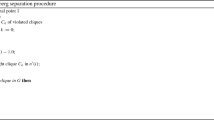Abstract
We show how the resolution method of theorem proving can be extended to obtain a procedure for solving a fundamental problem of integer programming, that of finding all valid cuts of a set of linear inequalities in 0-1 variables. Resolution generalizes to two cutting plane operations that, when applied repeatedly, generate all strongest possible or “prime” cuts (analogous to prime implications in logic). Every valid cut is then dominated by at least one of the prime cuts. The algorithm is practical when restricted to classes of inequalities within which one can easily tell when one inequality dominates another. We specialize the algorithm to several such classes, including inequalities representing logical clauses, for which it reduces to classical resolution.
Similar content being viewed by others
References
V.J. Bowman, Constraint classification on the unit hypercube, Management Sciences Research Report No. 287, Graduate School of Industrial Administration, Carnegie Mellon University, Pittsburgh, PA 15213 (Revised July 1972).
G.H. Bradley, P.L. Hammer and L.A. Wolsey, Coefficient reduction for inequalities in 0-1 variables, Math. Progr. 7 (1975) 263–282.
V. Chvátal, Edmonds polytopes and a hierarchy of combinatorial problems, Discr. Math. 4 (1973) 305–337.
S.A. Cook, The complexity of theorem-proving procedures,Proc. 3rd Annual ACM Symp. on the Theory of Computing (1971) pp. 151–158.
M.R. Genesereth and N.J. Nilsson,Logical Foundations of Artificial Intelligence (Morgan Kaufmann, 1987).
M. Guinard and K. Spielberg, Logical reduction methods in 0-1 programming (minimal preferred variables), Oper. Res. 29 (1981) 49–74.
A. Haken, The intractability of resolution, Theor. Comp. Sci. 39 (1985) 297–308.
J.N. Hooker, Generalized resolution and cutting planes, Ann. Oper. Res. 12 (1988) 217–239.
J.N. Hooker, A quantitative approach to logical inference, Decision Support Systems 4 (1988) 45–69.
J.N. Hooker, Input proofs and rank one cutting planes, ORSA J. Comput. 1 (1989) 137–145.
E.L. Johnson, M.M. Kostreva and U.H. Suhl, Solving 0-1 integer programming problems arising from large scale planning models, Oper. Res. 33 (1985) 803–819.
W.V. Quine, The problem of simplifying truth functions, Amer. Math. Monthly 59 (1952) 521–531.
W.V. Quine, A way to simplify truth functions, Amer. Math. Monthly 62 (1955) 627–631.
Author information
Authors and Affiliations
Additional information
Supported in part by Air Force Office of Scientific Research, Grant number AFOSR-87-0292.
Rights and permissions
About this article
Cite this article
Hooker, J.N. Generalized resolution for 0–1 linear inequalities. Ann Math Artif Intell 6, 271–286 (1992). https://doi.org/10.1007/BF01531033
Issue Date:
DOI: https://doi.org/10.1007/BF01531033




